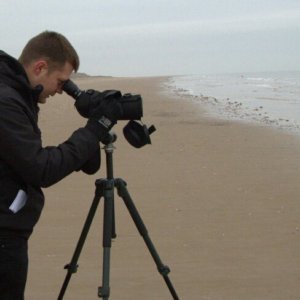
Joe Harkness writes about the therapeutic benefits of birdwatching on his Bird Therapy blog and Twitter page @BirdTherapy
In July, Chris Packham and a team of experts are embarking on a nationwide bioblitz of 50 wildlife sites over ten days. The tagline of the campaign is that nature reserves are not enough! – which got me thinking about how little of my time birdwatching is actually spent at reserves. I prefer the comfort, security and solitude of my local patch. I’ve decided to share with you two extracts from my book ‘Bird Therapy’ – taken from a chapter about my local patch, named ‘A chalet park, some diving ducks and a mountain Blackbird’. The first is about finding my beloved patch:
“The search began with the unfurling of an Ordnance Survey map. A crackle of crisp paper and the scent of knowledge flooded the senses. The sight of a vast, miniature world settling on the living-room carpet. Such graceful grid squares of order and logic. There’s an intrinsic magic about the curves and contours of your local area being condensed into a two-dimensional illustration. A childhood fascination of mine. It needed habitats and as many as possible in one place, for surely this would bring more variety in bird species?
Our heralded wildlife reserves all feature an abundance of habitats, interwoven into a web of sustenance – thus providing for a range of avifauna. Scanning the map, a nearby lake leapt out. A blue-washed, stomach-shaped blot on the page, labelled as Haveringland Hall Lake. Its north-east edge annexed by the wonderfully named Great Wood and spitting distance from the familiar location of Buxton Heath. Amalgamation occurred, at least mentally. A patch was forming.”
The second is from later in the chapter, with some of my patch observations:
“The new year rolled in and on its second day came the inaugural patch ramble. It was a cold, crisp morning with every exhalation billowing like pipe smoke. The shrubbery on the approach to the lake glistened with a diamante frosting. The icy avenue was still and quiet – a stark paradox to the clamour of Christmas and New Year. A clean slate – the records for the day make for interesting reading. A wider range of birds were observed and accurate counts reflect a thorough and focused walk round. A Little Egret was the undoubted highlight; now beholding an almost mythical status at the patch – with no more than one or two seen each year.
Another January surprise came the following weekend in the form of a fine water-bird – a Goosander. It was the first bird seen that morning, darting purposefully across the ornamental lake. This Drake, with his bottle-green head and clean white body, was a joy to behold. A hunched and vaguely reptilian bird, armed with a saw-like bill; the origin of their collective family name – the sawbills. Goosanders’ can turn up on any inland body of water during winter, but there, so soon after getting to know the place, felt like it carried more significance.
The following month brought fresh surprises. Records note a number of new birds for the park including, the first of many Kingfisher sightings – a bird that would take on an iconic resonance in the story of Bird Therapy. Similarly, with the Skylark, also a new bird that month, heard serenading over the adjacent fields. Every visit yielded impressive numbers of Gadwall – fifties and sixties. To most, a fairly regular duck, much like the perception of the Dunnock described in chapter three. Catch a Drake in sunlight and be dazzled as their grey feathers reflect metallic silver.”
You can support the publication of my book, Bird Therapy, by contributing to the crowdfunding campaign here. Although Bird Therapy is now 100% funded and will be published, if you would still like to your name in print as a supporter of an important book and message, then the crowdfund will still be open to pledges for a few more months yet.
[registration_form]